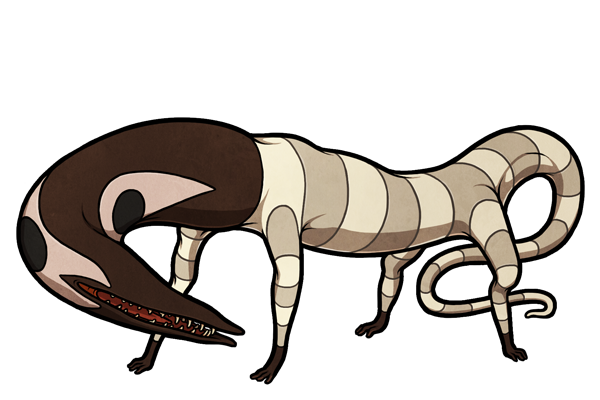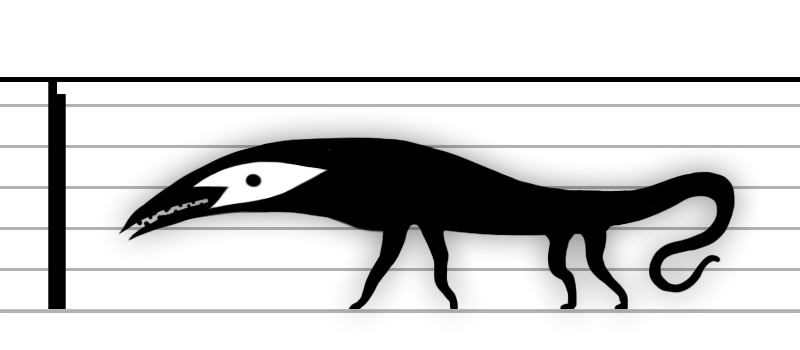

ferorodrevi
the small hunters
prefix feroro suffix drevi
7666 3435111
physical appearance
The ferorodrevi /fəˌɹɔɹɪˈdɹɛvi/ is a ruddy-colored stranger with a sloped posture, a large upper body, and distinctive markings on the sides of its head and neck. Its skin is rubbery with a smoothly ridged texture, emitting no heat despite the ferorodrevi's warm inner flesh. Its hands and feet are small, while its limbs are long and strong. The ferorodrevi's gums are lined with small, white teeth, and its mouth leads directly into a simple internal body cavity which, although stomach-like, connects to no other structures. Its muscular flesh is thick, black, and sinewy, and exudes a ferrous scent.
Although the ferorodrevi's body is supple and flexible, it does rust when exposed to moisture. This rusting process causes its inner flesh to solidify and grow brittle, as well, and the corpses of ferorodrevi killed in this manner resemble loose, flaky, iron-like shells. Otherwise, the ferorodrevi displays substantial resistance to extremes of temperature, owing in part to its thick skin. Its regenerative ability is slow, but hardy. Even deep gashes close up within several weeks, with no bleeding or infection, and only limited scarring.
It speaks only with a snarling rattle.
a growl that is not like that of a person or animal.

environment and generation
The ferorodrevi appears in a wide range of environments, and always appears outdoors. A majority of ferorodrevi appear near or during dusk, but rarely does it appear at night proper. It also generates slightly more frequently around neglected fire escapes, hanging cables, and on the unpaved ground; this correlation, however, is so negligible as to be within the realms of coincidence.
The ferorodrevi starts off as a rusty pool on the ground, which coalesces to form the stranger's body in a process lasting up to an hour in length. Once fully formed, the ferorodrevi stands up and begins its normal behaviours. It does not form within two miles of sensitives, and dissolves back into rust if its formation is interrupted at any point.
behaviour and effects
The ferorodrevi possesses a dogged, determined demeanor. It is always on the move, and runs with the agile lope of a wild animal. It is quick and vigorous, and displays no difficulty scaling fences, vaulting cars, or leaping from rooftop-to-rooftop. It does not enter interior spaces, however, and appears to avoid tunnels and underpasses, as well. Due to its sturdy form, the ferorodrevi has no difficulty surviving a jump even from several stories. While the ferorodrevi does not cause deliberate harm to its surroundings, it is capable of damaging its environment by denting rooftops with its heavy body, breaking glass windows as it climbs, and knocking down flimsier fences and gates.
Though not willfully destructive, the ferorodrevi's touch causes rust to appear on metal (barring stainless steel and other rust-resistant alloys). This rust develops after only a few seconds, but does not spread beyond the area touched by the ferorodrevi's body. Thus, the ferorodrevi's paths can be identified by the trails of rusty footprints it leaves behind on car hoods, tins roofs, and dumpsters.
While the ferorodrevi does not exhibit careful grooming behaviours, during infrequent periods of rest, it does rub its shoulders, underbelly, or neck against hard objects to scrape off any accumulated rust. Despite its tendency towards oxidation, it does not avoid water, nor does it seek shelter during inclement weather. Due to this, most ferorodrevi die of the complications of rust well before reaching the end of their natural lifespan.
predation of other strains
The ferorodrevi displays a marked propensity for predation, and tracks down and devours other strangers. The ferorodrevi's small but sharp teeth are able to tear through even thick flesh, and do not wear down or become broken as it yanks apart tomodari, shreds drosodroni, and bites into the sides of buledroni. Groups of ferorodrevi may hunt in synchronicity, particularly in pursuit of larger strangers, although their activities display no apparent structure or communication between individuals.Ꮕ While more violent strainsꝒ do fight back against these attacks, the highly durable ferorodrevi remains undeterred (even fighting to the death), and its numerical advantage usually results in the upper hand. The ferorodrevi does, however, ignore those strangers that remain impervious to its attacks.ⱡ
Ꮕ Not pack animals, but ( ... ) in pursuit of some shared goals.
Ꝓ Such as the haledroni.
ⱡ Such as the metallic smoldroni, or the cement-bodied fressidrene.
Groups always fully ingest their kills, and even slurp up puddles of blood and bile. Once all matter has been devoured, the group continues in search of the next suitable trail. Consumed flesh dissolves to nothing inside the ferorodrevi's internal cavity, leaving behind only a vaguely metallic smell on the ferorodrevi's breath as a by-product of digestion.
interactions with sensitives
The ferorodrevi displays no interest in sensitives, and its constant gallop tends to limit interactions to brief, passing observations. Aggression is returned in full, but only as a defensive behaviour; a sensitive who strikes a ferorodrevi with a pipe will be rewarded with a quick bite of the arm before the stranger returns to its pursuit of prey, and bands of ferorodrevi do not defend their companions.
aging and death
The ferorodrevi displays no properties of aging, but, instead, dies suddenly.
The dead ferorodrevi's flesh continues to oxidize, until, after several weeks, it fully disintegrates into a pile of rust chips and gritty dark particles. Other ferorodrevi, after consuming their fallen companions, are quick to continue on in their perpetual hunt.



